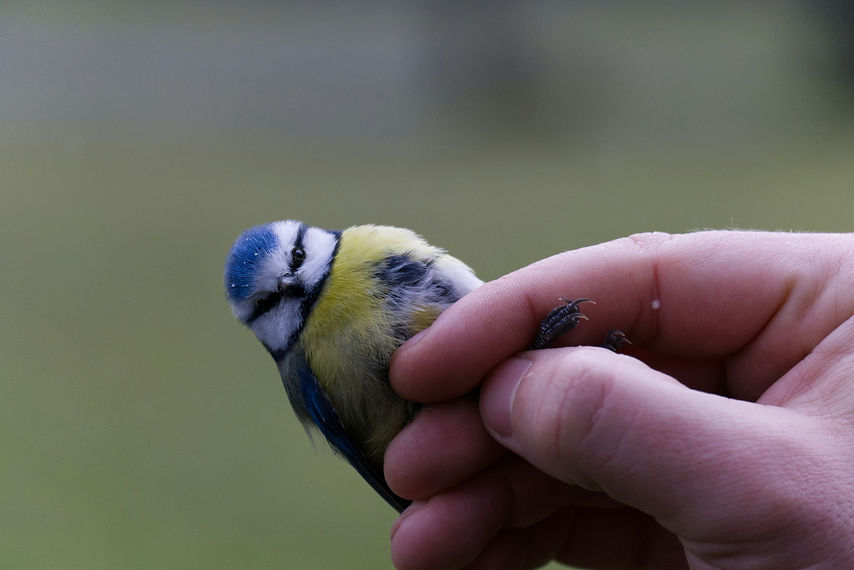NORTH CORNWALL BIRD RINGING GROUP

WHAT IS BIRD RINGING?
Bird ringing involves placing a small metal ring onto a bird's leg, this doesn't cause them pain or disrupt them in their everyday life - but it does provide amazing benefits!
Ringing generates information on the survival, productivity, and movements of birds, helping us to understand why populations are changing. Ringing birds is essential if we are to learn about how long they live and when and where they move, questions that are vital for bird conservation.
Did you know the BTO Ringing Scheme was established over 100 years ago?
This was so they could begin to study the movements of birds. Today, not only can we use it to study migration and dispersal, but we can use it to understand population change.
‘Population modeling’ may sound like a complex process, but the basic principle is relatively straightforward – bird numbers are determined by the number of fledglings produced and the subsequent survival of both those youngsters and their parents.

WHY IS RINGING IMPORTANT?
A key aim for the BTO is to understand how populations change in order to inform effective conservation policies. The demographic monitoring schemes have a critical part to play in this by providing information on survival, productivity and dispersal with which to interpret data on abundance collected by schemes such as the Breeding Bird Survey and Wetland Bird Survey.
So how can ringing birds provide data on survival? Each BTO metal ring bears a unique number, enabling individuals to be identified on subsequent encounter. Until recently, survival rate calculations were based on numbers of dead birds reported by members of the public, which works well for larger species that tend to meet their end in obvious places, such as Blackbirds and Barn Owls; but when was the last time you saw a dead Willow Warbler? However, advances in statistical techniques have allowed survival to be calculated from recaptures of previously ringed birds, so the question shifts from ‘How many birds do we know have died?’ to ‘How many do we know are still alive?’. These ‘recapture models’ have many advantages, but the results are influenced by the likelihood of encountering those individuals that have survived.
Furthermore, information about connectivity of breeding, resting and wintering areas as well as survival data within and among populations is crucial information for any conservation action. This data can only be collected through marked individuals, and bird ringing still is the easiest and cheapest way to gather suitable sample sizes for sound analyses. Migrating birds are global players and what (in a human sense), could be called their “home” is, of course, not restricted to the breeding ground! Not surprisingly, reasons for population declines or increases do not always lie in the area where a bird raises its young. Ringed and recovered birds show conservationists where their breeding grounds, stopover sites and wintering areas are situated. This enables investigation of what is happening there and if any conservation action is required.
More information can be found on the BTO website here: https://www.bto.org/our-science/projects/bird-ringing-scheme/about-ringing/why-ring-birds and in the EURING Bird Ringing for Science and Conservation guide found here: https://euring.org/files/documents/brochure2007/EURING_brochure_english_2007.pdf
THE RINGING PROCESS
01
Capturing Birds:
In order to capture birds to ring, we use specially designed traps, nets, or mist nets to capture birds in a safe and ethical manner. Although mist netting can look drastic, it is one of the safest ways to capture birds without harming them.


02
Ringing birds
Once a bird is captured, a small, uniquely numbered metal ring is carefully attached to its leg. This ring has information about the BTO and a unique identification number. In some cases, additional data, such as location and date, may be included.
03
Ageing the bird
Did you know you can age birds from how they molt their feathers? Birds will molt their feathers at different times of the year and in a specific order - which is really useful for us as we can often gauge how old they are just by using their feathers!


04
Collecting biometrics
Once we have safely ringed and aged the bird, we can collect some biometric data on it, such as its weight and wing length. This can help us to determine things such as sex, and to allow changes in species to be tracked.
05
Releasing the bird

Once all the data has been collected, the bird is ready to go back into the wild! We aim to ring the bird as quickly and safely as possible so that it can return to its family group promptly! We'll release them back into the scrub where they came from.

06
Retraps
Occasionally a bird with a ring on gets re-caught, we call these 'retraps'. This is always really exciting, as it means we can take down the ring number and find out where it has come from, where it was ringed and get an idea on how long it has been alive!
LEARN MORE
Want to learn more about bird ringing?
The British Trust of Ornitholgy have some brilliant resources for you to learn more about the process and its importance.
Additionally, the EURING Bird Ringing for Science and Conservation guide have some brilliant information about how ringing can be used to protect species.